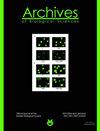外食毛虫鉴定的标准描述矩阵
IF 0.8
4区 生物学
Q4 BIOLOGY
引用次数: 0
摘要
鳞翅目植物外食幼虫的鉴定是生物多样性清查、拟寄生虫进化研究和物种监测等生物学科研究的必要条件。这一领域专业知识的缺乏影响了鳞翅目幼体多层次可塑性的进一步研究和记录。本文对现有的随机方法进行了改进,开发了41个包含150种形态、行为和生态状态的简化字符及其描述、视觉验证和83种异种的描述矩阵。将这些状态与所有可能的鉴定情景相结合,该矩阵揭示了上述物种的582个形态、生境和资源多表型。数据的分类性质意味着使用分类主成分分析来可视化没有特征关系假设的判别能力。采用目标点双标图推导K模式聚类的K值,同时引入聚类隶属度作为标记变量,进一步检验聚类模式。这一描述性分析研究的结果表明,描述性矩阵将允许不断扩展和精细检查许多不同的物种组合。从交互式识别密钥到机器学习训练,所提出的框架可以使数据存储和解释更加容易实现。本文章由计算机程序翻译,如有差异,请以英文原文为准。
Standard descriptive matrices in the identification of exophytophagous caterpillars
Identification of exophytophagous lepidopteran larvae is a necessity for researchers in biological disciplines ranging from biodiversity inventorying to research in parasitoid evolution and species monitoring. The lack of expertise in the field jeopardizes the outcomes of further investigations and recording of the multilevel plasticity of juvenile Lepidoptera. This paper offers an improvement to the existing haphazard approach by developing 41 simplified characters that include 150 morphological, behavioral and autecological states and their delineation, visual validation, and a descriptive matrix for 83 heterogeneous species. By combining the states into all possible identification scenarios, the matrix revealed 582 morphological, habitat and resource polyphenisms for the mentioned species. The categorical nature of the data implied the use of categorical principal component analysis to visualize the discriminative capacity without character relationship assumptions. The object-point biplot was used to derive the K value for K-mode clustering, while the cluster membership was introduced as a labeling variable to further inspect the grouping pattern. The results of this descriptive-analytic research indicate that descriptive matrices will allow continuous expansion and fine examination of many different species assemblages. From interactive identification keys to machine learning training, the presented framework can make data storage and interpretation significantly more attainable.
求助全文
通过发布文献求助,成功后即可免费获取论文全文。
去求助
来源期刊
CiteScore
1.40
自引率
0.00%
发文量
25
审稿时长
3-8 weeks
期刊介绍:
The Archives of Biological Sciences is a multidisciplinary journal that covers original research in a wide range of subjects in life science, including biology, ecology, human biology and biomedical research.
The Archives of Biological Sciences features articles in genetics, botany and zoology (including higher and lower terrestrial and aquatic plants and animals, prokaryote biology, algology, mycology, entomology, etc.); biological systematics; evolution; biochemistry, molecular and cell biology, including all aspects of normal cell functioning, from embryonic to differentiated tissues and in different pathological states; physiology, including chronobiology, thermal biology, cryobiology; radiobiology; neurobiology; immunology, including human immunology; human biology, including the biological basis of specific human pathologies and disease management.

 求助内容:
求助内容: 应助结果提醒方式:
应助结果提醒方式:


